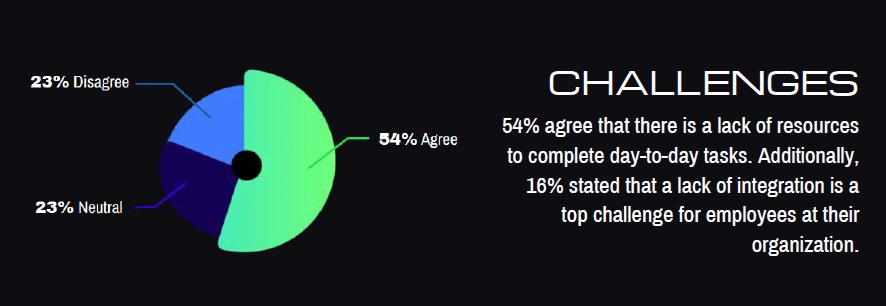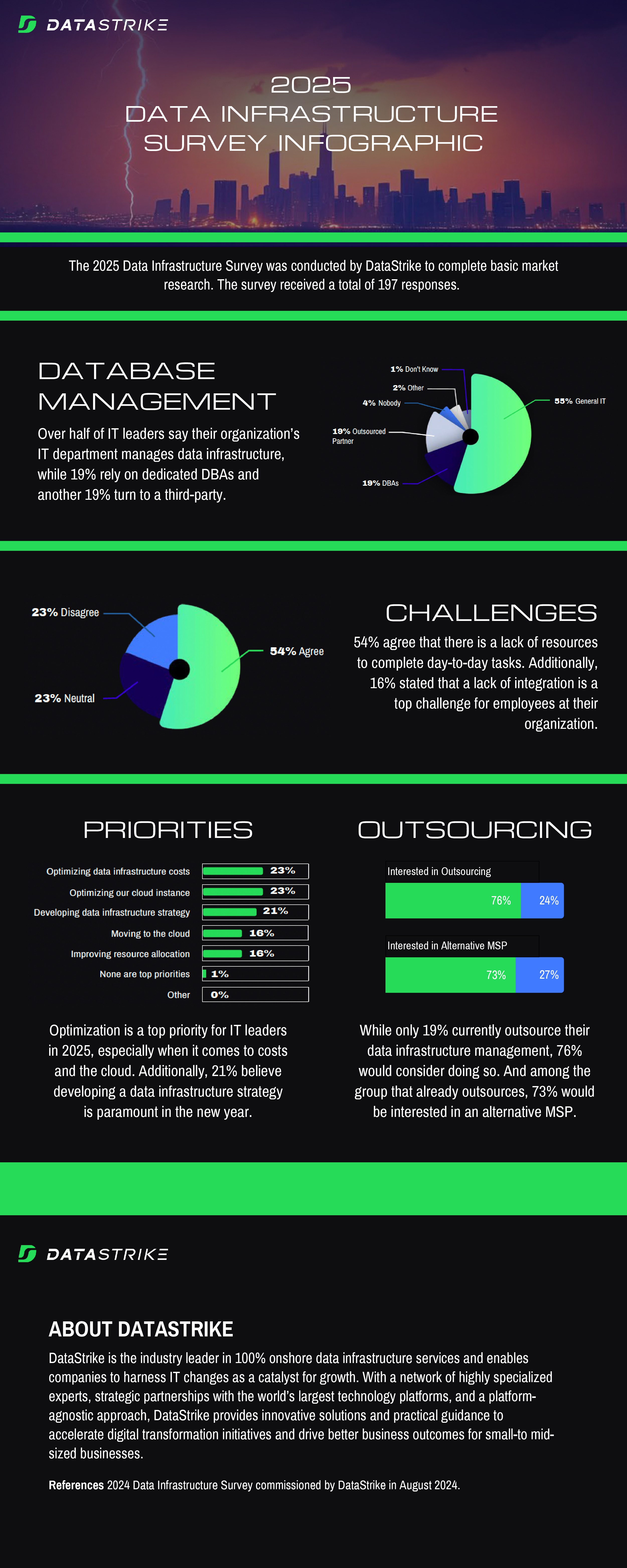The pressure on IT teams has never been greater. As data environments grow increasingly complex, resource shortages are emerging as a major obstacle for IT leaders striving to meet the demands of modern infrastructure management. A recent Harvey Nash survey revealed just 36% of CIOs expect IT headcount growth in the year ahead, the lowest figure since 2011.
According to DataStrike's newly released 2025 Data Infrastructure Survey Report, more than half (54%) of IT leaders cite resource limitations as a top challenge, highlighting a growing trend toward outsourcing as a solution.

The Growing Complexity of Data Infrastructure
Data is at the heart of innovation but managing it effectively has become an overwhelming task for many organizations. The survey, which gathered insights from nearly 200 IT leaders and decision-makers, underscores the reality: IT teams are being stretched thin. More than half (55%) of organizations rely solely on internal IT staff to manage their data infrastructure, and many of these teams are tasked with juggling multiple database platforms, cloud environments, and emerging technologies — all with limited resources and shrinking budgets.
The growing complexity of modern data infrastructure is driven by several trends.
First, the proliferation of cloud platforms has led to hybrid and multi-cloud environments becoming the norm, requiring teams to manage diverse ecosystems simultaneously.
Second, the demand for real-time data insights is pushing IT teams to adopt advanced tools for processing and analytics.
Finally, increased cybersecurity threats mean that IT leaders must also prioritize securing data systems against breaches and attacks — adding another layer of responsibility to their already full plates.
The survey highlights the scale of this challenge:
- Heavy Workloads: 49% of IT leaders report managing more than one database platform, significantly increasing the complexity of their work.
- Resource Demands: IT teams are handling an average of two database platforms and two cloud environments, further amplifying workload pressure.
- Priorities for 2025: 23% of respondents named cost optimization as a top priority, alongside cloud instance and the development of a comprehensive data infrastructure strategy, highlighting the rising costs and inefficiencies of managing complex databases.
The combination of these challenges has created a perfect storm for IT departments. With limited tools and resources, internal IT teams are often unable to fully optimize their data systems, which can lead to inefficiencies, bottlenecks, and rising costs.
Why IT Leaders Are Turning to Outsourcing
The findings also indicate a growing willingness among IT leaders to embrace external support. While only 19% of organizations currently outsource their data infrastructure management, the survey reveals a clear desire for change. A striking 76% of IT leaders expressed interest in outsourcing, and 73% of those already outsourcing are open to exploring new Managed Service Providers (MSPs).
This shift reflects a growing recognition of the benefits that outsourcing can deliver:
- Access to Expertise: MSPs provide specialized knowledge and experience that internal teams may lack. Data infrastructure management requires niche skills, including expertise in optimizing cloud workloads, managing database performance, and implementing robust security frameworks.
- Fractional Support Models: Outsourcing allows organizations to scale their support based on their needs without the overhead of full-time hires. IT leaders can access resources on a project-by-project basis or adopt ongoing support models tailored to their infrastructure requirements.
- Cost Optimization: Managed services can help reduce costs through improved efficiency and resource allocation. For example, outsourced providers can identify underutilized cloud resources, optimize storage, and streamline workflows to maximize ROI.
By outsourcing critical data infrastructure tasks, IT leaders can focus their internal teams on strategic initiatives, driving innovation while leaving day-to-day management in expert hands. For businesses striving to remain competitive, outsourcing offers a flexible solution that delivers immediate value without requiring significant internal restructuring.
Addressing Concerns Around Outsourcing
Despite the clear benefits, some IT leaders remain hesitant to outsource due to concerns around security, control, and integration. However, modern MSPs are equipped to address these concerns by offering:
- Robust Security Protocols: Leading MSPs implement stringent security measures to protect sensitive data, including encryption, real-time monitoring, and compliance with industry standards.
- Seamless Integration: Outsourced providers become an extension of internal IT teams to ensure smooth workflows and minimize disruption. Collaborative models ensure organizations retain control while benefiting from external expertise.
- Customizable Service Models: Businesses can tailor outsourced support to their specific needs, whether they require ongoing management, occasional project assistance, or a hybrid approach.
As IT teams continue to be stretched thin, MSPs can help ease their workload burden by bringing expertise in key areas internal teams may not possess.
Looking Ahead: Data Infrastructure Priorities in 2025
As businesses continue to navigate the challenges of managing modern data environments, the survey highlights a clear opportunity for organizations to rethink their approach to data infrastructure management. By leveraging fractional support models and partnering with experienced MSPs, IT leaders can overcome resource limitations and position their organizations for success.
The survey also emphasizes the importance of proactive planning in 2025. With 23% of respondents naming cost optimization as a top priority, organizations will need to adopt smarter strategies for resource allocation. Cloud optimization, performance monitoring, and automation will play central roles in achieving these goals.
Additionally, IT leaders are increasingly focusing on building comprehensive data infrastructure strategies that align with long-term business objectives.
A Path Forward for IT Leaders
With cost optimization, cloud strategy, and operational efficiency at the top of IT leaders' priority lists, the message is clear: internal IT teams need more support. Outsourcing may well be the key to unlocking the full potential of today's data-driven organizations.
The report serves as a reminder for IT decision-makers. In a world where resource shortages and mounting workloads threaten to stifle innovation, outsourcing offers a proven solution to alleviate pressure, reduce costs, and drive meaningful outcomes.
The future of data infrastructure lies in collaboration. By partnering with experienced MSPs and embracing flexible support models, organizations can transform their approach to infrastructure management, ensuring they remain agile, secure, and positioned for growth in 2025 and beyond.

